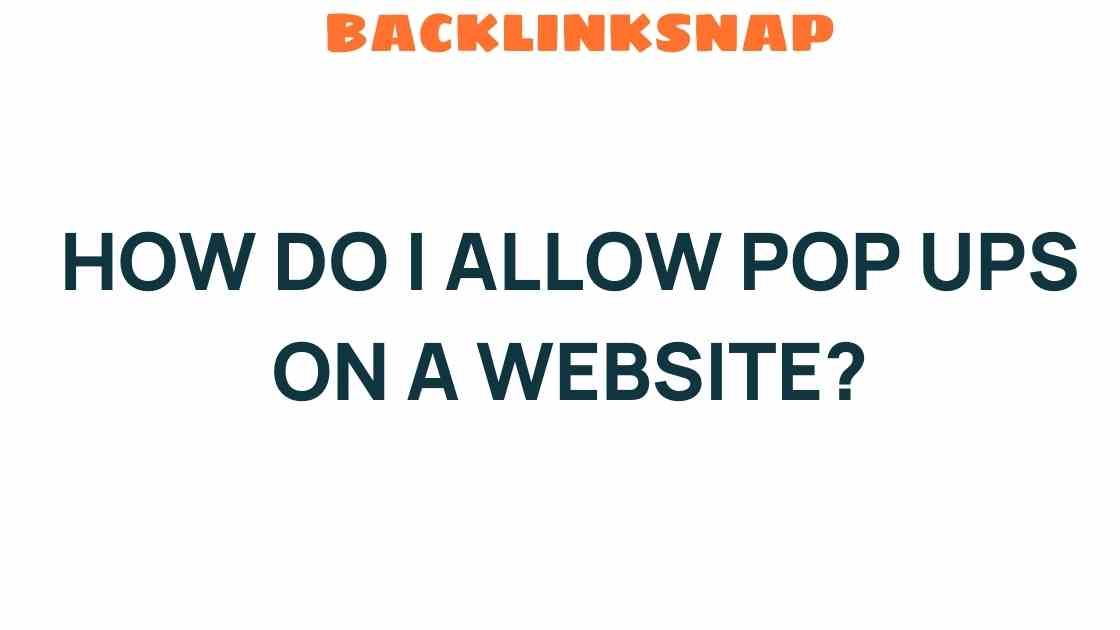Unlocking the Secret: How Do I Allow Pop Ups on a Website?
In the modern digital landscape, pop-ups often evoke mixed feelings. Some users find them intrusive, while others appreciate their functionality. Nevertheless, understanding how to allow pop-ups on a website can enhance your online experience, improve site functionality, and boost online engagement. This article will guide you through the intricacies of pop-ups, browser permissions, and website settings, ensuring you get the most from your web interactions.
Understanding Pop-Ups
Pop-ups are windows that appear unexpectedly on your screen, often prompting you for an action. They can serve various purposes, including:
- Collecting email addresses for newsletters
- Providing important notifications or updates
- Offering discounts or promotions
- Enhancing user experience with additional content
While pop-ups can improve user engagement, many browsers and ad-blockers are designed to prevent them from appearing. This can lead to frustration when valuable content is missed. Thus, knowing how to allow pop-ups on a website becomes essential.
Why You Might Need to Enable Pop-Ups
Allowing pop-ups can significantly improve your browsing experience. Here are a few reasons why it’s worth considering:
- Enhanced User Experience: Some websites use pop-ups to deliver personalized content, such as recommendations based on your browsing history.
- Increased Site Functionality: Pop-ups can facilitate actions like booking appointments, filling forms, and making purchases without navigating away from the main page.
- Effective Digital Marketing: Businesses often use pop-ups for lead generation, offering promotions that can entice users to engage more deeply with their brand.
How to Allow Pop-Ups on Different Browsers
Now that we understand the importance of pop-ups, let’s break down how to enable them across various popular browsers. Each browser has its own set of settings for managing pop-up permissions.
Google Chrome
To allow pop-ups in Google Chrome, follow these steps:
- Open Chrome and click on the three dots in the upper right corner.
- Select Settings from the dropdown menu.
- Scroll down and click on Privacy and security.
- Click on Site settings.
- Under Content, find Pop-ups and redirects.
- Toggle the setting to Allowed or add specific sites under the Allowed to send pop-ups and use redirects section.
Mozilla Firefox
For Mozilla Firefox users, enabling pop-ups is straightforward:
- Click on the three horizontal lines in the upper right corner.
- Select Options.
- Click on Privacy & Security.
- Scroll down to the Permissions section.
- Check the box next to Block pop-up windows to disable it, or click Exceptions to add specific sites.
Microsoft Edge
To allow pop-ups in Microsoft Edge:
- Open Edge and click on the three dots in the upper right corner.
- Select Settings.
- Click on Cookies and site permissions.
- Scroll down and click on Pop-ups and redirects.
- Toggle the setting to Allowed or add specific sites.
Safari
For Safari users on macOS:
- Open Safari and click on Safari in the top menu.
- Select Preferences.
- Click on the Websites tab.
- Find Pop-up Windows on the left side.
- Choose Allow next to the websites you want to enable pop-ups for.
Dealing with Ad-Blockers
Ad-blockers can often prevent pop-ups from appearing, even if you’ve enabled them in your browser settings. If you’re using an ad-blocker, consider whitelisting specific websites to allow their pop-ups. This can usually be done by:
- Clicking on the ad-blocker icon in your browser.
- Selecting the option to Whitelist or Allow on the specific website.
Improving User Experience with Pop-Ups
When used correctly, pop-ups can enhance the user experience significantly. Here are a few tips for website owners:
- Timing: Use pop-ups sparingly and ensure they appear at the right moment, such as when users show intent to leave the page.
- Relevance: Ensure the content of the pop-up is relevant to the user’s interests and browsing behavior.
- Design: Keep pop-ups visually appealing and easy to close to avoid user frustration.
FAQs
1. Why are pop-ups blocked by default?
Most browsers block pop-ups by default to enhance user experience and prevent intrusive advertising.
2. Are all pop-ups bad?
No, while some pop-ups are annoying, many provide valuable information or offers that enhance the user experience.
3. How do I know if a website needs pop-ups?
If a website prompts you to allow pop-ups, it’s likely trying to deliver content or functionality that enhances your experience.
4. Can enabling pop-ups harm my computer?
Generally, allowing pop-ups from reputable sites is safe. However, be cautious with unknown sites to avoid malware.
5. What if I still don’t see pop-ups after enabling them?
Check your ad-blocker settings or browser extensions, as they may still be preventing pop-ups from appearing.
6. How do pop-ups affect digital marketing?
Pop-ups, when used effectively, can lead to higher conversion rates by engaging users and prompting them to take action.
Conclusion
Allowing pop-ups on a website can unlock a wealth of information and engagement opportunities. By understanding browser permissions and taking control of your user experience, you can navigate the digital world more effectively. Whether you’re a casual user or a digital marketer, embracing the functionality of pop-ups can lead to enhanced interactions and better site functionality. So, don’t shy away from exploring the benefits of pop-ups—after all, they could be the key to a more engaging online experience. For additional resources, check out this guide on browser settings and explore how pop-ups can enhance your digital marketing strategies through effective campaigns.
This article is in the category Digital Marketing and created by BacklinkSnap Team




